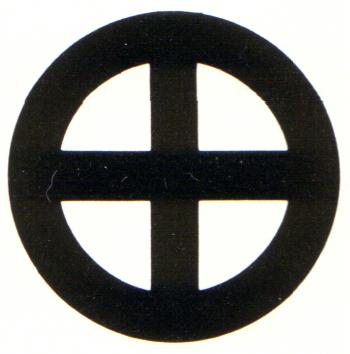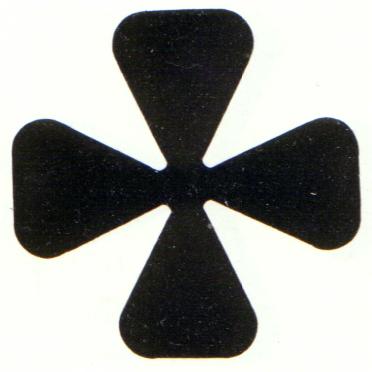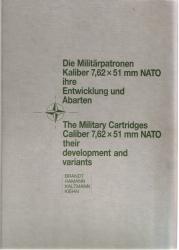 |
History and Development of the 7.92x57mm Cartridge |  |
|
|
|
|
Firearms Technical Trivia, July 2001:
 |
History and Development of the 7.92x57mm Cartridge |  |
INTRODUCTION
If there is one cartridge which
can be said to have set the pattern for military and sporting rifle cartridges
during the twentieth century, and from which most other cartridges can
be said to be derivative, it is the German 7.9mm Model 88 cartridge, also
known as the 8mm Mauser. Indeed, with the exception of the
intermediate cartridges designed in the wake of the Second World War,
Many shooters are aware of the differences between the dimensionally similar 7.62mm NATO cartridge and the .308 Winchester. What most are not aware of is that all cartridges called "7.62mm NATO" are not created equal, and that there is significant variation, both dimensionally and ballistically, between 7.62mm NATO cartridges as manufactured by different countries, and even between such cartridges as manufactured by different arsenals within the same country. As a result, the terms "NATO spec" or "NATO standard," which imply that all "NATO" cartridges are the same or to indicate the fitness of given 7.62x51mm ammunition for a specific use, are misleading. In this month's technical trivia, we will explore the wide range of variation encountered in ammunition allegedly adhering to the "NATO standard."
With the adoption of the US T65 cartridge as the "7.62mm NATO," the British Army quietly shelved its indigenously developed EM2 rifle and .280 cartridge. These two cartridges had been the finalists in the competition for a new standard cartridge for the NATO alliance. In many ways, it was a contest between the old and the new; the .280, unlike the T65, was a true intermediate cartridge, designed with lessons learned during the Second World War in mind. The T65 by contrast, was little more than the .30-06 US service cartridge in a slightly shorter package. Knowledgeable European (and many American) observers were not shy about commenting on this development. One referred to the adoption of the T65 as "barking up the wrong tree," while another called it "a setback by fifty years in the field of ammunition technology." Nevertheless after the decision was taken, plans were made in the NATO member states, as well as a number of other countries to start domestic manufacture of the new 7.62mm NATO. Each of these nations conducted their own production tests and experiments. As a result, there is an amazing amount of heterogeneity to be found among cartridges supposedly manufactured to a standard.
HISTORY
During World War Two, it became
obvious that the traditional infantry weapons, chambered for large and
heavy cartridges ranging in caliber from 6.5mm to 8mm, were becoming eclipsed
by the changing requirements of modern warfare. The old cartridges
weighed almost an ounce and a half, which meant that the infantryman had
to carry approximately fourteen pounds of ammunition in order to sustain
a basic load of 150 rounds. These rounds, while capable of use against
a man-sized target at ranges up to 2,000m, were all but impossible to translate
into the new generation of selective fire infantry shoulder weapons.
What was needed was an "intermediate cartridge" that delivered similar
lethality out to 500m, but with a lower recoil impulse and a lower per
cartridge weight. This was first given form with the German sturmgewehr
series of rifles chambered for the 7.92x33mm cartridge. The Soviet
Union followed suit with the 7.62x39mm cartridge and the the Kalashnikov
assault rifle series.
The west, however, was somewhat behind in intermediate cartridge development. Since the early 1940's new infantry weapons that would provide useful selective fire options for the average infantryman had been sought. The American T-20 rifle was one example of such a development. The T-20 was little more than an M1 Garand rifle modified for selective fire and capable of accepting a box magazine. However, as it was chambered for the .30-06 cartridge, the T-20 was ultimately a failure. Spain, Belgium, Switzerland, and England all had similar programs under development. The one factor uniting all these efforts was the need for a standard armament, or at least a standard cartridge for the NATO infantry units. All of these nations, with the exception of the United States were designing their respective rifles around an intermediate cartridge design. The US, by contrast, was working on the T-65 cartridge, a shorter version of the full power .30-06, adapted from the .300 Savage cartridge. The design underwent a number of changes, gradually lengthening the case design from 47.24mm to 47.64mm to 49.52mm to a final length of 50.8mm. The US, having tremendous fiscal and military influence on the nascent NATO and its emergent policies, exercised this influence over the selection of the T-65 as the alliance's standard rifle cartridge. (Editor's note: That's a polite way of saying that the US ordnance establishment crammed the cartridge down the collective European throat.)
The T-65 was initially presented in 1950 along with the experimental T-25 rifle. Firing a 146 grain projectile, the T-65 produced a muzzle velocity of 2,750 feet per second. These ballistics, roughly comparable to the wartime .30-06, were achieved through the use of a new double based powder that required less volume to produce similar velocities. During the winter of 1953, representatives of the five leading NATO member states met and agreed upon the standardization of the T-65 as the 7.62mm NATO cartridge.
STANDARDIZATION
MARKINGS and MEANINGS
In August 1959, the NATO Department
of Military Standardization published the NATO identification marking.
The NATO identification mark is a cross within a circle. All types
of ammunition standardized by NATO and adhering to the terms of the Standardization
Agreement (STANAG) bears this mark, indicating that the cartridge in question
is interoperable with others so marked. However, it cannot be stressed
enough that this marking alone does not guarantee interchangeability.
That is to say, a random selection of 7.62mm NATO cartridges from different
manufacturers bearing the cross-within-circle marking will likely display
equally random ballistic performance. Only the inclusion of an additional
marking on the cartridge packaging in the form of a maltese cross or four
leafed clover indicates that the ammunition is expected to provide identical
ballistic performance. If the clover symbol is framed, this is an
indication that the accessories contained within the packaging such as
clips or links also correspond to designs approved by the STANAG.
 |
 |
Based on the existence of these two distinct markings, it is evident that there are at least two types of NATO 7.62mm military ammunition. The first, bearing only the cross-in-circle marking, will function in all 7.62mm rifles and machineguns fielded by NATO armies, but may or may not provide the expected ballistic performance. The second, bearing both markings, will not only function in all arms, but will provide the ballistic performance prescribed in the STANAG (a 147 +/- 3 grain bullet with a muzzle velocity of 2,750 +/- 50 feet per second). The picture is muddied further for the US consumer of surplus 7.62mm NATO ammunition by the fact that many nations produced three types of military 7.62x51mm cartridges:
COLOR CODING
7.62mm NATO cartridges are loaded
with many types projectiles in addition to the standard ball loading.
Within the nations subscribing to the STANAG, special purpose cartridges
are differentiated from the standard ball loading NATO cartridges with
projectile tip color codes. These codes are explained in the following
table:
|
|
|
| Ball | No color code |
| Tracer | Red |
| Armor Piercing | Black |
| Armor Piercing Tracer | Red Tip atop Black Band |
| Incendiary | Light Blue |
| Incendiary Tracer | Red Tip atop Light Blue Band |
| Armor Piercing Incendiary | White |
| Armor Piercing Incendiary Tracer | Red Tip atop White Band |
| Spotter | Chrome Yellow |
| Spotter Tracer | Red Tip atop Yellow Band |
CARTRIDGE
VARIATIONS
As noted earlier,
there is significant variation among supposedly "standard" 7.62mm NATO
cartridges. In the following tables are quantitative comparisons
of representative 7.62mm NATO ball cartridges from various countries.
AUSTRIA
|
|
|
|
|
|
|
| Ball | 2.795" | 375 grains | 1.122" | 146.14 grains | 43.52 grains |
| Ball | 2.791" | 364.2 grains | 1.136" | 147.38 grains | 43.21 grains |
| Ball | 2.883" | 367.28 grains | 1.128" | 145.99 grains | 42.44 grains |
| Ball | 2.789" | 378.08 grains | 1.120" | 145.83 grains | 43.67 grains |
| Ball | 2.793" | 381.94 grains | 1.130" | 146.60 grains | 44.75 grains |
| Ball | 2.795" | 362.03 grains | 1.122" | 145.68 grains | 43.21 grains |
| Ball | 2.787" | 375 grains | 1.118" | 145.99 grains | 43.98 grains |
Averages
|
|
|
|
|
|
|
| 2.805" | 371.93 grains | 1.125" | 146.23 grains | 43.54 grains |
Maximum Deviation between Min and Max
|
|
|
|
|
|
|
| .096" | 19.91 grains | .018" | 1.7 grains | 2.31 grains |
BELGIUM
|
|
|
|
|
|
|
| Ball | 2.776" | 370.37 grains | 1.134" | 143.52 grains | 43.83 grains |
| Ball | 2.787" | 370.00 grains | 1.131" | 143.70 grains | 45.37 grains |
| Ball | 2.789" | 371.45 grains | 1.134" | 143.36 grains | 45.83 grains |
| Ball | 2.795" | 368.36 grains | 1.134" | 147.63 grains | 44.75 grains |
| Ball | 2.797" | 368.82 grains | 1.142" | 143.98 grains | 44.91 grains |
| Ball | 2.783" | 370.52 grains | 1.140" | 143.52 grains | 43.98 grains |
| Ball | 2.689" | 342.59 grains | 0.902" | 122.68 grains | 43.98 grains |
Averages
|
|
|
|
|
|
|
| 2.774" | 366.02 grains | 1.102 | 141.20 grains | 44.66 grains |
Maximum Deviation between Min and Max
|
|
|
|
|
|
|
| .108 | 28.86 grains | .232" | 24.95 grains | 2 grains |
CANADA
|
|
|
|
|
|
|
| Ball | 2.780" | 372.68 grains | 1.134" | 146.91 grains | 44.44 grains |
| Ball | 2.786" | 384.72 grains | 1.159" | 147.53 grains | 47.22 grains |
Averages
|
|
|
|
|
|
|
| 2.783" | 378.70 grains | 1.147 | 147.22 grains | 45.83 grains |
Maximum Deviation between Min and Max
|
|
|
|
|
|
|
| .006" | 12.04 grains | .025" | .62 grains | 2.78 grains |
GERMANY
|
|
|
|
|
|
|
| Ball | 2.770" | 346.60 grains | 1.102" | 142.59 grains | 35.96 grains |
| Ball | 2.795" | 367.59 grains | 1.124" | 146.60 grains | 41.67 grains |
| Ball | 2.783" | 374.38 grains | 1.124" | 146.91 grains | 44.14 grains |
| Ball | 2.791" | 376.39 grains | 1.122" | 145.83 grains | 43.98 grains |
| Ball | 2.791" | 379.01 grains | 1.128" | 146.30 grains | 46.14 grains |
| Ball | 2.799" | 368.05 grains | 1.124" | 151.23 grains | 42.44 grains |
| Ball | 2.791" | 377.62 grains | 1.121" | 145.37 grains | 43.21 grains |
Averages
|
|
|
|
|
|
|
| 2.789" | 369.95 grains | 1.121" | 146.40 grains | 42.51 grains |
Maximum Deviation between Min and Max
|
|
|
|
|
|
|
| .029" | 31.02 grains | .026" | 8.64 grains | 10.18 grains |
DENMARK
|
|
|
|
|
|
|
| Ball | 2.789" | 368.05 grains | 1.114" | 143.52 grains | 44.75 grains |
| Ball | 2.787" | 367.13 grains | 1.130" | 144.91 grains | 43.67 grains |
Averages
|
|
|
|
|
|
|
| 2.788" | 367.59 grains | 1.122" | 144.22 grains | 44.21 grains |
Maximum Deviation between Min and Max
|
|
|
|
|
|
|
| .002" | .92 grains | .016" | 1.39 grains | 1.08 grains |
SPAIN
|
|
|
|
|
|
|
| Ball | 2.807" | 384.10 grains | 1.270" | 186.00 grains | 43.67 grains |
| Ball | 2.795" | 363.27 grains | 1.122" | 145.99 grains | 41.82 grains |
Averages
|
|
|
|
|
|
|
| 2.801" | 373.69 grains | 1.196" | 166.00 grains | 42.75 grains |
Maximum Deviation between Min and Max
|
|
|
|
|
|
|
| .012" | 20.83 grains | .148" | 40.01 grains | 1.85 grains |
FRANCE
|
|
|
|
|
|
|
| Ball | 2.783" | 363.73 grains | 1.150" | 148.15 grains | 41.67 grains |
| Ball | 2.787" | 348.76 grains | 1.122" | 145.06 grains | 43.98 grains |
| Ball | 2.791" | 345.68 grains | 1.150" | 146.60 grains | 43.36 grains |
| Ball | 2.795" | 358.79 grains | 1.090" | 139.81 grains | 45.06 grains |
| Ball | 2.793" | 357.71 grains | 1.091" | 140.73 grains | 43.98 grains |
| Ball | 2.785" | 364.35 grains | 1.076" | 141.05 grains | 43.67 grains |
| Ball | 2.787" | 335.34 grains | 1.079" | 139.51 grains | 41.67 grains |
Averages
|
|
|
|
|
|
|
| 2.789" | 353.48 grains | 1.108" | 142.99 grains | 43.34 grains |
Maximum Deviation between Min and Max
|
|
|
|
|
|
|
| .012" | 18.05 grains | .074" | 8.64 grains | 3.39 grains |
GREAT BRITAIN
|
|
|
|
|
|
|
| Ball | 2.787" | 373.15 grains | 1.126" | 146.30 grains | 43.98 grains |
| Ball | 2.797" | 359.87 grains | 1.132" | 142.13 grains | 44.75 grains |
| Ball | 2.787" | 362.96 grains | 1.130" | 144.91 grains | 42.13 grains |
| Ball | 2.794" | 374.38 grains | 1.131" | 141.82 grains | 42.44 grains |
| Ball | 2.785" | 380.40 grains | 1.122" | 144.60 grains | 42.13 grains |
| Ball | 2.795" | 380.71 grains | 1.134" | 144.44 grains | 43.36 grains |
| Ball | 2.787" | 379.94 grains | 1.142" | 144.29 grains | 42.44 grains |
Averages
|
|
|
|
|
|
|
| 2.790" | 373.06 grains | 1.131" | 144.07 grains | 43.03 grains |
Maximum Deviation between Min and Max
|
|
|
|
|
|
|
| .01" | 20.84 grains | .02" | 4.48 grains | 2.62 grains |
ITALY
|
|
|
|
|
|
|
| Ball | 2.787" | 371.45 grains | 1.146" | 147.99 grains | 44.91 grains |
| Ball | 2.795" | 363.27 grains | 1.122" | 145.99 grains | 43.21 grains |
Averages
|
|
|
|
|
|
|
| 2.791" | 367.36 grains | 1.134" | 146.99 grains | 44.06 grains |
Maximum Deviation between Min and Max
|
|
|
|
|
|
|
| .008" | 8.18 grains | .024" | 2 grains | 1.7 grains |
NETHERLANDS
|
|
|
|
|
|
|
| Ball | 2.791" | 360.49 grains | 1.127" | 135.96 grains | 38.89 grains |
| Ball | 2.791" | 375.31 grains | 1.126" | 147.07 grains | 43.36 grains |
| Ball | 2.795" | 371.91 grains | 1.126" | 145.06 grains | 40.43 grains |
| Ball | 2.793" | 371.60 grains | 1.091" | 145.06 grains | 45.06 grains |
| Ball | 2.793" | 372.99 grains | 1.132" | 144.60 grains | 43.98 grains |
| Ball | 2.795" | 373.30 grains | 1.131" | 146.30 grains | 43.98 grains |
Averages
|
|
|
|
|
|
|
| 2.793" | 370.93 grains | 1.122" | 144.01 grains | 42.61 grains |
Maximum Deviation between Min and Max
|
|
|
|
|
|
|
| .004" | 14.82 grains | .041" | 11.11 grains | 6.17 grains |
PORTUGAL
|
|
|
|
|
|
|
| Ball | 2.795" | 368.52 grains | 1.134" | 144.91 grains | 45.83 grains |
| Ball | 2.795" | 368.52 grains | 1.130" | 146.30 grains | 45.83 grains |
| Ball | 2.795" | 370.68 grains | 1.130" | 146.14 grains | 43.83 grains |
Averages
|
|
|
|
|
|
|
| 2.795" | 369.24 grains | 1.131" | 145.78 grains | 45.16 grains |
Maximum Deviation between Min and Max
|
|
|
|
|
|
|
| 0" | 2.16 grains | .004" | 1.39 grains | 2 grains |
ARGENTINA
|
|
|
|
|
|
|
| Ball | 2.772" | 380.86 grains | 1.131" | 143.36 grains | 43.83 grains |
| Ball | 2.780" | 387.19 grains | 1.132" | 153.55 grains | 43.52 grains |
| Ball | 2.791" | 383.49 grains | 1.138" | 143.98 grains | 43.06 grains |
| Ball | 2.795" | 380.71 grains | 1.142" | 142.28 grains | 44.75 grains |
| Ball | 2.787" | 380.40 grains | 1.132" | 142.75 grains | 45.52 grains |
| Ball | 2.799" | 374.84 grains | 1.128" | 144.13 grains | 41.67 grains |
| Ball | 2.779" | 355.71 grains | 1.122" | 143.21 grains | 40.89 grains |
Averages
|
|
|
|
|
|
|
| 2.786" | 377.60 grains | 1.132" | 144.75 grains | 43.32 grains |
Maximum Deviation between Min and Max
|
|
|
|
|
|
|
| .027" | 31.48 grains | .02" | 10.8 grains | 4.63 grains |
SWEDEN
|
|
|
|
|
|
|
| Ball | 2.783" | 364.97 grains | 1.110" | 143.52 grains | 45.83 grains |
| Ball | 2.793" | 374.69 grains | 1.130" | 146.91 grains | 44.75 grains |
| Ball | 2.795" | 374.23 grains | 1.138" | 146.76 grains | 45.99 grains |
| Ball | 2.795" | 368.05 grains | 1.126" | 143.67 grains | 45.52 grains |
| Ball | 2.791" | 362.65 grains | 1.132" | 143.67 grains | 45.52 grains |
| Ball | 2.789" | 359.57 grains | 1.126" | 143.67 grains | 45.83 grains |
| Ball | 2.789" | 367.74 grains | 1.120" | 147.53 grains | 46.14 grains |
Averages
|
|
|
|
|
|
|
| 2.791" | 367.41 grains | 1.126" | 145.10 grains | 45.74 grains |
Maximum Deviation between Min and Max
|
|
|
|
|
|
|
| .012" | 15.12 grains | .028" | 4.01 grains | 1.39 grains |
UNITED STATES
|
|
|
|
|
|
|
| Ball | 2.791" | 377.31 grains | 1.118" | 147.07 grains | 45.37 grains |
| Ball | 2.785" | 371.91 grains | 1.168" | 147.07 grains | 44.75 grains |
| Ball | 2.791" | 373.76 grains | 1.112" | 147.07 grains | 46.61 grains |
| Ball | 2.789" | 373.61 grains | 1.130" | 149.40 grains | 40.60 grains |
| Ball | 2.793" | 371.91 grains | 1.108" | 147.07 grains | 44.29 grains |
| Ball | 2.768" | 370.68 grains | 1.150" | 148.15 grains | 43.83 grains |
| Ball | 2.789" | 371.29 grains | 1.116" | 146.76 grains | 45.83 grains |
Averages
|
|
|
|
|
|
|
| 2.787" | 372.92 grains | 1.129" | 147.51 grains | 44.47 grains |
Maximum Deviation between Min and Max
|
|
|
|
|
|
|
| .025" | 6.63 grains | .06" | 2.64 grains | 6.01 grains |
CUMULATIVE
AVERAGES
A "typical"
7.62mm NATO cartridge was defined by averaging the averages from each of
the national sample sets. The results are shown below:
Cartridge Dimension Averages, Multinational
|
|
|
|
|
|
|
| 2.790" | 369.99 grains | 1.130" | 146.61 grains | 43.95 grains |
Maximum Deviation between Min and Max, Multinational
|
|
|
|
|
|
|
| .025" | 16.49 grains | .053" | 8.74 grains | 3.44 grains |
Ballistically,
these figures provide some very interesting results. Using IMR 4895
powder and a 147 grain bullet as our baseline, we assumed a velocity difference
of 78 feet per second per grain of propellant added or removed. Incorporating
the average deviation in propellant alone, we arrive at the following ballistic
table, illustrating the resulting variations in bullet drop at different
ranges:
|
|
|
|
|
|
|
|
|
|
|
|
|
|
|
|
|
|
|
|
|
|
|
|
|
|
|
|
|
|
|
|
|
|
|
|
|
|
|
|
|
|
|
|
|
|
|
|
|
|
|
|
|
|
|
|
|
|
|
|
|
|
|
|
|
|
|
|
|
|
|
|
As can be seen, the effects of the "average" deviation in propellant charges are quite dramatic, with the most significant ballistic differences being noted at ranges in excess of 400 yards.
CONCLUSION
The 7.62mm NATO cartridge, as produced
by both NATO alliance members and other nations whose armies adopted weapons
chambered for the round, displays as surprising degree of dimensional uniformity.
Average case and projectile dimensions are nearly identical across the
measured samples. Just as striking, however, are the variations in
projectile weights and powder charges. Powder charge variations average
in excess of three grains, and in some cases varied as much as ten grains.
Bullet weights demonstrated similar extreme variations, with a low of 122
grains and a high of 186 grains.
Evident then is an emphasis on interoperability rather than interchangeability. 7.62mm NATO cartridges from various sources can be expected to chamber and fire in a wide variety of weapons. What they cannot and should not be expected to provide is a similar level of ballistic performance. For the rifleman who engages his targets at an average range of 400 yards or less, the difference in performance is trivial. For support weapons designed to cover the 400 to 1200 yard zone, it is critical, determining the difference between effective and ineffective fires.
What of the collector and shooter, using whatever bargain priced 7.62mm NATO ammunition is available? There are a couple rules that can be gleaned:
Note: Data for this month's trivia page was gathered from:
Brandt, Hamann, Kaltmann, and Kiehn, The Military Cartridges Caliber 7.62mm NATO, Their Development, and Variants, Journal-Verlag Schwend GMBH (Germany)
The Military
Cartridges Caliber 7.62mm NATO, Their Development, and Variants is
available from IDSA Books. Click on the image to order:
